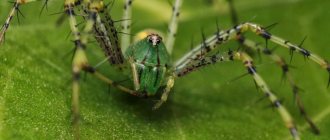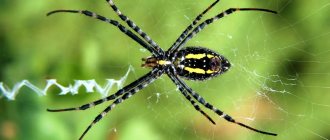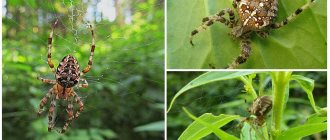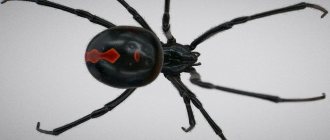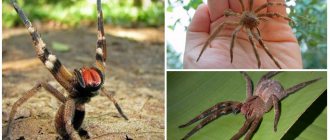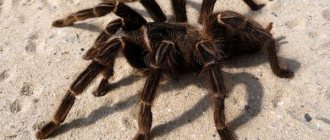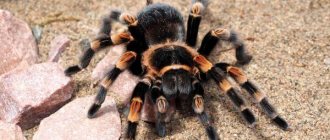- Wild animals
- >>
- Arachnids
The wolf spider is a sprinter in the arachnid world. It does not spin webs, but instead stalks and attacks its prey like a wolf. If you've seen this spider near your home, the encounter was probably memorable. Some people find them beautiful and unique, while others tremble at the sight of them.
Wolf spiders can be mistaken for tarantulas because they have thick, hairy bodies. Although they look menacing, they are useful and harmless organisms. Their diet consists of many pests that can enter people's homes.
Origin of the species and description
Photo: Wolf spider
Wolf spiders or ground spiders or huntsman spiders are members of the family Lycosidae, the name comes from the ancient Greek word "λύκος", meaning "wolf". This is a large and widespread group.
Wolf spiders got their name in honor of the wolf’s habit of attacking prey in a whole pack. Initially it was believed that these insects also attack in swarms. This theory has now been proven wrong.
There are over two thousand species included in 116 genera. About 125 genera are found in North America, about 50 in Europe. Numerous varieties are found even north of the Arctic Circle.
The evolution of spiders has been going on for 380 million years. The first spiders evolved from crustacean ancestors. More than 45,000 existing species have now been described. Fossil diversity rates account for a larger proportion than would be predicted by current arachnid diversity. The main stages of evolution include the development of spinnerets and the release of webs.
Video: Wolf Spider
Among the ancient terrestrial arthropods, trigonotarbites, representatives of the extinct order of arachnids, stand out. They have many characteristics identical to spiders, including being terrestrial, breathing, and walking on eight legs with a pair of foot pedals near the mouth. However, it is unknown whether they had the ability to create webs. Trigonotarbides are not true spiders. Most of their species have no living descendants.
Kinds
The family of wolf spiders is quite large - it includes more than 2 thousand species, which are combined into 116 genera. Moreover, representatives of each species hunt in their own way. Some can be active during the daytime, looking out for potential prey for several hours. Others prefer to forage at dusk. There are also passive wolf spiders that will peacefully wait for their prey to approach right in their burrow.
The most famous species of wolf spiders include:
- Apulian tarantulas are quite large arthropods, the body size of which can be about 7 cm. Representatives of this species prefer to settle on the slopes of mountains, where they dig their burrows and frame the entrance to them with a roll of fallen leaves. For a long time they were considered very poisonous, and in order to save your life after being bitten you had to start a quick dance.
On a note! This is how the Italian folk dance - tarantella - was born!
- The second most famous wolf spider is also a tarantula - the South Russian tarantula. Representatives of this species are recognized as the largest spiders living in Russia. The body length of adult males is approximately 2.5 cm, females - 3 cm. South Russian tarantulas are colored dark brown, brown-red or black. They live in burrows, from which they try not to stray far even while hunting.
Appearance and features
Photo: Spider wolf animal
Most wolf spiders are small to medium in size. The largest individual is about 2.5 cm long and its legs are about the same length. They have eight eyes arranged in three rows. The bottom row has four tiny eyes, the middle row has two huge eyes, and the top row has two medium-sized eyes. Unlike other arachnids, they have excellent vision. The sensual hair on their legs and body gives them a keen sense of touch.
Flashing a beam of light towards a wolf spider produces an amazing glow caused by the light reflecting from the eyes back to its source, thus creating a "glow" that is easy to notice.
Because spiders rely on camouflage for protection from predators, their coloring does not have the bright, provocative colors of some other spider species. External colors correspond to the favorite habitat of a particular species. Most wolf spiders are dark brown. The hairy body is long and wide, with strong, long legs. They are famous for their speed of movement. They can be easily identified by the number and location of their eyes. The jaws are prominent and strong.
Wolf spiders have a primitive structure:
- the cephalothorax performs the functions of vision, food absorption, breathing and is responsible for the motor system;
- The abdominal cavity contains the internal organs.
Life expectancy depends on the size of the species. Small varieties live for six months, larger species - 2 years, sometimes longer. Fertilized females or born spiders survive the winter.
Hogna is the largest genus of wolf spiders, with over 200 species found on all continents. Many smaller genera of wolf spiders live in pastures and fields and feed on smaller prey, playing an important role in natural population control that keeps insect numbers in close proximity to wolf spiders.
Description of the spider
Appearance
The family includes more than two thousand species of spiders.
The sizes of the largest representatives of the family exceed 3 cm. Females are usually smaller than males. Wolf spiders are hairy, usually gray, brown or black brown in color, often with a pattern of spots. They, like all spiders, have eight limbs, and the body consists of a cephalothorax and abdomen. The entire abdomen is covered with hair, and the front legs have three claws. These spiders have eight eyes arranged in three rows. There are three tiny eyes in front, two large eyes in the second row, and three medium-sized eyes in the back.
It is believed that wolf spiders, unlike other types of spiders, have very good eyesight, which helps them when hunting.
Nutrition and lifestyle
Wolf spiders are predators. They feed on aphids, mosquitoes and flies and their larvae; many wolf spiders readily eat leafhoppers and bedbugs. Spiders hunt on the ground. They can often be found in
forest floor. They usually move along the surface of the soil; only a few individuals climb plants.
Different species have different hunting strategies. Some wolf spiders actively hunt during daylight hours, while others search for prey at night and during the day sit in recesses lined with cobwebs. Some species of wolf spiders build a burrow and ambush their prey. Vagrant species attack prey by jumping, and then devour it, holding it with their forelimbs.
Reproduction
Species living in temperate climates mate in the summer, while tropical species breed year-round. At first, the male tries to get the female to notice him. To do this, he moves his forelimbs in a special way, slowly approaching her. If the female shows favor, she turns to the male and puts her forelimbs together. Along them, the male climbs onto the female’s back, and mating begins. The male injects sperm into the genitals
females with the help of a special organ located on the second pair of limbs - the pedipalps.
After fertilization, the female looks for a secluded place. There she weaves a spherical cocoon where she lays her eggs. The female wolf spider wears the cocoon on her body for several weeks, where it is attached to the tip of the abdomen using a spinneret. The rate of egg development depends on temperature, so the expectant mother begins to spend a lot of time in the sun, and not hide in the shade during the day, as before. When the spiderlings emerge from the eggs, the mother breaks the cocoon with her powerful jaws-chelicerae, and the spiderlings, one by one, move onto her back. When the very first spider leaves the cocoon, it leaves a web along which all its brothers and sisters climb onto the mother.
Until their first molt, they do not get off their mother's back and do not eat anything. Then the female finds a suitable damp, shaded place, the spiderlings descend to the ground and begin to live on their own.
Where does the wolf spider live?
Photo: Poisonous wolf spider
Wolf spiders can live anywhere except Antarctica. Some species are found on cold, rocky mountain tops, while others live in volcanic lava tunnels. They can be found in deserts, tropical forests, meadows and suburban lawns. One species has even been found in wheat crops, feeding on pests such as aphids.
Some species of wolf spiders live in underground burrows, while most are found in green natural landscapes. They can often be found hidden in areas of the yard that provide spiders with cover and protection, including:
- in leaves and around plants or shrubs;
- in tall or dense grass;
- under long-sitting heaps and stacks of wood.
Unlike their four-legged namesakes, wolf spiders do not hunt in packs. They are lonely wolves who don't want to meet people. Spiders of the genus Pirata are often found near ponds or streams and have a V-shaped pale marking on their back. They run on the smooth surface of the water without diving and hunt insects on the surface of the water. Burrowing wolf spiders (Geolycosa) spend most of their lives in burrows and have heavy front legs that are used for digging.
If one is inside the house, it's likely they've come to escape extreme temperatures outdoors or because they're chasing another insect indoors. Wolf spiders try to move unnoticed through rooms at floor level. They do this by crawling along walls or under furniture.
Wolf spider: characteristics of the family. Features of behavior
For some reason, the stereotype that all spiders weave webs has taken root in the minds of many people. More precisely, that they cannot live without it and this is the only way they are able to catch their victims. Well, the wolf spider can dispel this prejudice.
And if outwardly this marvelous creature is not very different from its relatives, then its habits and hunting tactics deserve special attention. It’s not for nothing that this predator is called the “wolf spider,” and now we’ll explain why.
What does a wolf spider eat?
Photo: Male wolf spider
Wolf spiders do not spin webs to catch their prey; they are true hunters and detect potential food visually or by vibration with their sensitive hairs. They often set up ambushes and pounce on their prey on the sly or give it a real chase.
Their menu may vary between insects such as:
- crickets;
- grasshoppers;
- beetles;
- ants;
- other spiders;
- aphid;
- flies;
- cicadas;
- moths;
- caterpillars;
- cockroaches;
- mosquitoes
Some huntsman spiders pounce on prey when they find it or even chase it short distances. Others wait until the prey passes nearby or sit down near the hole. Once wolf spiders catch their prey, they either mash it into a ball or inject it with venom, turning the poor thing's internal organs into a smoothie. They eat their victims by pressing them to the ground or other surface with their paws. The spider can immobilize large victims by injecting a toxic substance.
The limbs of spiders have 48 knee bends, that is, each leg has 6 joints. The wolf spider will inject venom if constantly provoked. Symptoms of its bite include swelling, mild pain and itching.
In the past, necrotic bites were often attributed to certain South American species of wolf spiders, but research has shown that the problems that occurred were caused by bites from other genera. Australian members of the species have also been associated with necrotic wounds, but careful examination of the bites also showed a negative result.
Behavior in the wild
The wolf does not weave a web for hunting, but uses the web to close its hole. The spider is one of the most important insects in the ecosystem because it reduces the number of harmful parasites. Wolves provide invaluable help on the farm when they catch and exterminate hordes of garden crop pests.
They reproduce by mating. Males send signals that attract females. After mating, the female begins to weave a cocoon where she lays eggs. She does this in several layers to create a ball shape. At first, the female carries the cocoon with her, firmly attaching it to the spinning organ. Mating occurs in the summer, in temperate climates, and all year round in tropical climates.
After a few days, the spiderlings hatch. The female herself feels this and tears the cocoon with her fangs. According to the external description, the family of spiderlings looks the same as the female. The wolf is a spider that carries children on its back until they can get their own food. A large individual is capable of carrying more than 40 children. There can be so many of them that the only free place the female has is her eyes.
If you find a wolf in your garden or home, it is better not to kill it. Find a safe way to drive the individual away. The whole point is that they are useful for the environment. Spiders protect crops from pests and insects. But if there are children living in the house, or they often walk on the playground, it is advisable to get rid of them (the poison is very dangerous for a child).
Features of character and lifestyle
Photo: Female wolf spider
Wolf spiders live alone. Most of the species spend time on the ground. The dark, speckled colors of their bodies help them blend in with decaying vegetation when they hunt or hide from predators. They sometimes dig burrows or make holes under rocks and logs to live in.
Some members of Lycosidae, such as H. carolinensis, make deep burrows in which they hide most of the time. Others, such as H. helluo, seek refuge under rocks and other cover that nature provides. As they wander from place to place, they can end up in people's homes when the weather turns cold. Males of almost any species can sometimes be found inside buildings as they wander around looking for females in the fall.
Instead of blood, spiders have hemolymph, which contains copper. Once outdoors, it turns blue. Veins + arteries are completely absent, communication between organs is carried out using hemolymph.
Most species build tubular nests in the ground lined with spider webs. Some hide the entrance with trash, others build a tower-like structure over the entrance. At night they leave their secret hideout and go hunting. The spider tries to find a convenient place so that the insect can pass by. From a distance of several centimeters, the wolf spider jumps forward and grabs its prey.
Characteristic
As you can see in the photo, the wolf spider has a primitive body structure - it is divided into a cephalothorax and abdomen. The covers are usually dark and colored black, brown or dark gray. Light-colored individuals are extremely rare. Thanks to their color, wolf spiders are able to camouflage perfectly - they almost completely blend into their environment.
Representatives of this family have pronounced sexual dimorphism: females are much larger than males, while the latter have darker integuments, and a pair of forelimbs is much better developed. The forelegs are used by males to attract the attention of females and during mating.
As for vision, wolf spiders have relatively good vision. They have 4 pairs of eyes, arranged in 3 rows: on the bottom row there are two pairs of small eyes, in the middle there is a pair of the largest ones, in the top row there are two lateral eyes, which are located slightly above the middle pair.
This is interesting! Thanks to good vision and a well-developed sense of smell, wolf spiders are able to detect potential prey from a fairly impressive distance - about 30 cm. But it is believed that these creatures are not able to distinguish shape!
The relationship between the organs of the wolf spider's body is ensured by transparent hemolymph, which acts as blood. It has one peculiarity - as soon as the spider goes out into the open air, the hemolymph turns blue.
Social structure and reproduction
Photo: Wolf spider
When it's time to mate, males attract females by rhythmically flapping their long mouth parts (palps) or drumming them on leaves. The male approaches the female for mating with his front pair of legs raised. Readiness to mate is probably demonstrated by a scent that can be heard even at a distance of one meter.
Males of the species Allocosa brasiliensis may eat a female with poor reproductive capabilities or an old female incapable of reproducing. This biological fact was recorded for the first time.
The male then makes circular movements in accordance with the fixed pattern of the legs (pedipalps), in which the seed pockets are located. The mating female responds by tapping her front legs and takes a few steps towards the male, who then resumes courtship. This continues until they are almost touching. In nocturnal species, acoustic signals play an important role, while in daytime species, optical signals play an important role.
The male crawls onto the female's front and bends down on one side of the abdomen to insert the first palpus. A woman flattens her belly. Then a second palpus is inserted from the other side. Wolf spiders are unique in that they carry their eggs with them in a cocoon. After mating, the female spins a round web sac containing eggs, attaches it to spinnerets at the end of her abdomen, and carries the unborn cubs with her.
This species of spider has extremely strong maternal instinct. If the female has somehow lost her cocoon with her cubs, she becomes very restless and begins to wander aimlessly, trying to find it. If she fails to find the pouch, the female grabs any object that resembles it. These can be tiny pieces of cotton wool, cotton fibers, etc. In this way, she is trying to create the illusion of bearing children.
The stomach should be in a raised position so that the bag does not drag on the ground. But even in this position, females are able to hunt. Another aspect characteristic of wolf spiders is their method of caring for their young brood. Immediately after the spiders emerge from the soft, protected cover, they climb up the mother’s legs onto her back.
Hundreds of small wolf spiders cling to the mother's hairs and sit on her in several layers, feeding on the epidermis. At this time, the mother wanders around to find the best microclimatic conditions and good shelter for her children. To avoid danger, she gives up hunting for about eight days. The mother carries the spiders for several weeks before they become large enough to fend for themselves.
What to eat, how to live, how to raise children
The web of the wolf spider bears little resemblance to the creations of the weaving brothers.
Wolf spiders are solitary, they live in burrows, inside of which everything is entangled in a thick layer of cobwebs. They wander around their territory in search of prey, hunting insects and beetles.
In this type of spider, food production does not occur like everyone else, through the web, the wolf spider tracks down the beetle and rushes at it, or rushes at an insect passing by. They say the spider is capable of jumping 30 centimeters in length. They prefer beetles, sometimes flies, and very rarely insect larvae.
Depending on the species, wolf spiders mate in the summer, or generally throughout the year. The male attracts the female with his front paws, shaking and waving them, and if his partner likes him, she folds her paws and turns her abdomen towards him. The male rises and mating occurs. After mating, the female goes to a safe shelter, where she weaves a cocoon for the eggs, giving it a spherical appearance, and then attaching this ball to the spinning hole, and will wear it like this for almost a month until the offspring appear.
This is such a caring mother - a wolf-spider. Not for a second does he let go of his numerous offspring.
The female feels when the babies begin to appear, she breaks the cocoon, after which she places her cubs on her back, which are small but very exact copies of her. Depending on its size, a female can seat from 30 to 100 children on her back, sometimes with only one eye remaining free. Thus, the female carries them on herself until they learn to get food on their own.
Natural enemies of the wolf spider
Photo: Animal spider wolf
There are many predators that would love to feast on a wolf spider, but these arachnids have several defense mechanisms to help them avoid becoming victims of the food chain. Roaming species of wolf spiders use their agility and speed, as well as unique coloring that blends in with their environment.
Predators to watch out for include:
- wasps. They do not eat the spider, but temporarily paralyze it with a sting before inserting the egg inside. As the larvae mature, these nascent organisms eat the spider from the inside. Some wasps pull the spider towards their nest and completely suppress it, protecting the larvae. Other varieties place the egg inside and then allow the wolf spider to run free;
- amphibians and small reptiles. Amphibians also enjoy the delicious food provided by the wolf spider. Creatures such as frogs and salamanders are known to feed on various types of spiders. Amphibian predators will typically eat any creature small enough for them to swallow whole. Small reptiles such as snakes and lizards also eat wolf spiders, although larger species may skip this spider in favor of a larger meal;
- shrews and coyotes. Although wolf spiders are arachnids, they are close enough to insects that they are often preyed on by shrews. These tiny creatures require a constant intake of food to maintain their energy levels. Coyotes also sometimes eat wolf spiders;
- birds. While some birds prefer seeds and vegetation, other birds seek to enjoy live prey. Numerous bird species, including owls and elf hummingbirds, are predators of the wolf spider. These arachnids do not use webs, so they must go out to hunt and obtain food, which makes them vulnerable to attack from above.
If forced to fight, the wolf spider will bite its opponents with its large jaws. If faced with death, they are willing to sacrifice even a leg to survive the situation, although losing a leg makes them slower and more vulnerable to future attacks.
The importance of wolf spiders for nature and humans
Wolf spiders are mildly poisonous, but their bite, as a rule, does not pose a danger to humans. Due to their size and gray-brown coloring, they are sometimes confused with highly poisonous recluse spiders, but they differ in many ways, for example, the recluse spider has a characteristic violin-shaped spot on its back, while wolf spiders do not have such a spot. They are also distinguished by the number of eyes (wolf spiders have eight eyes, and hermit spiders have six) and a hairy abdomen.
Wolf spiders are usually non-aggressive and will not be the first to attack a person, but if they are constantly disturbed, they can bite. Bites from some tropical species can cause prolonged pain, dizziness, and nausea. The bite site swells. In this case, you need to consult a doctor.
The bite of wolf spiders living in Russia is not dangerous to humans.
In rare cases, itching or irritation may occur. If you are bitten by a wolf spider, wash the bite area with warm water and soap, and then apply a cool compress. If the bitten area is itchy, you can try mixing baking soda with water and applying the mixture to the bite area.
These arthropods play an important role in the ecosystem because they destroy various harmful insects. If wolf spiders have settled in your garden or vegetable garden, do not rush to destroy them. They rarely bite, their bite poses almost no danger, but they can bring great benefits.
Tsipromal is an effective remedy against insect pests that settle in the apartment. By artificially breeding Osmia bees, you can attract more of the best plant pollinators to your site. Read the article on how to breed these bees.
Androctonus thick-tailed is one of the most common species of venomous scorpions that live in bushes and deserts. You will find interesting information about this animal at the link.
